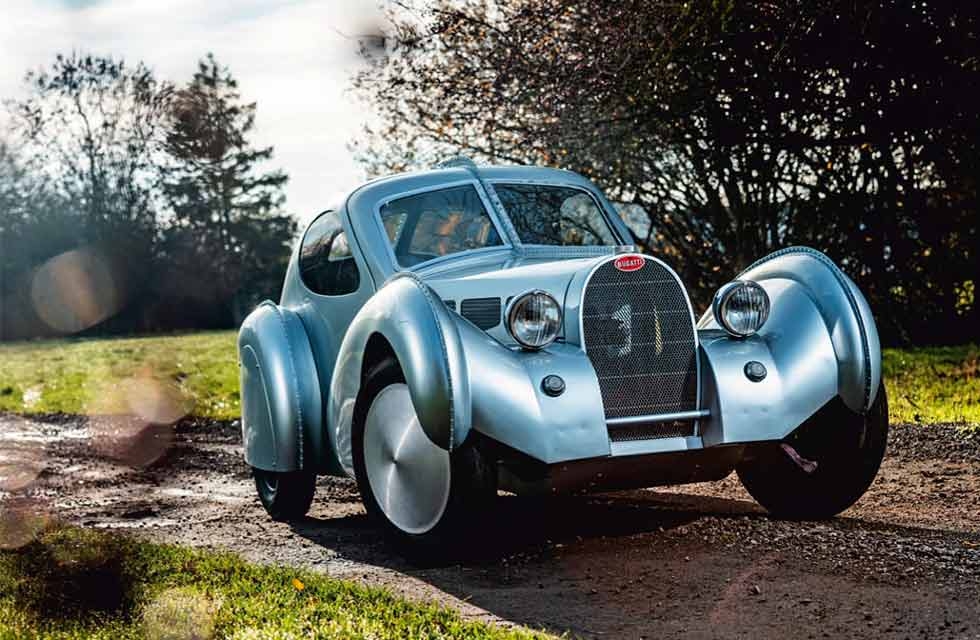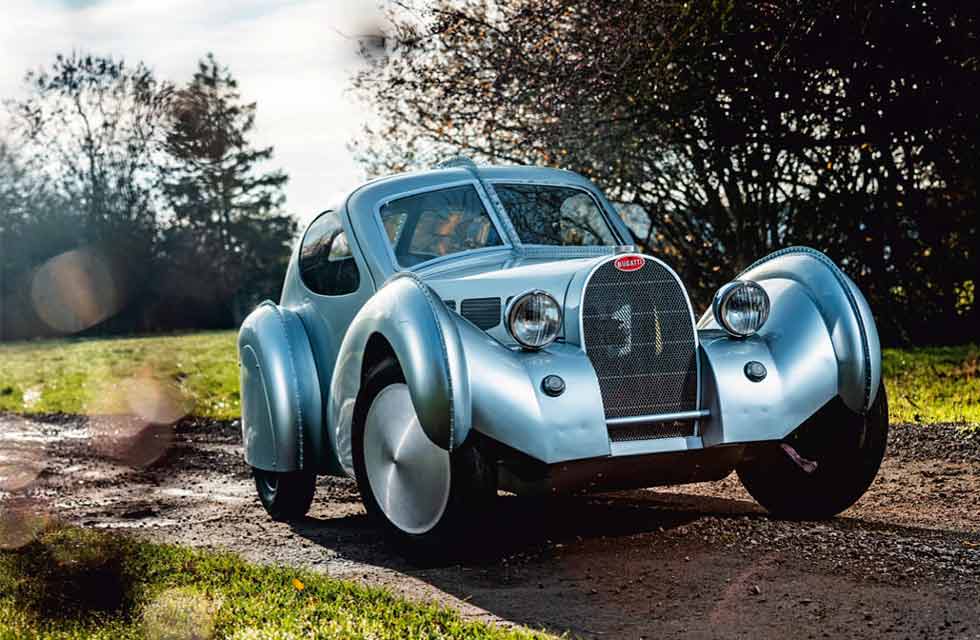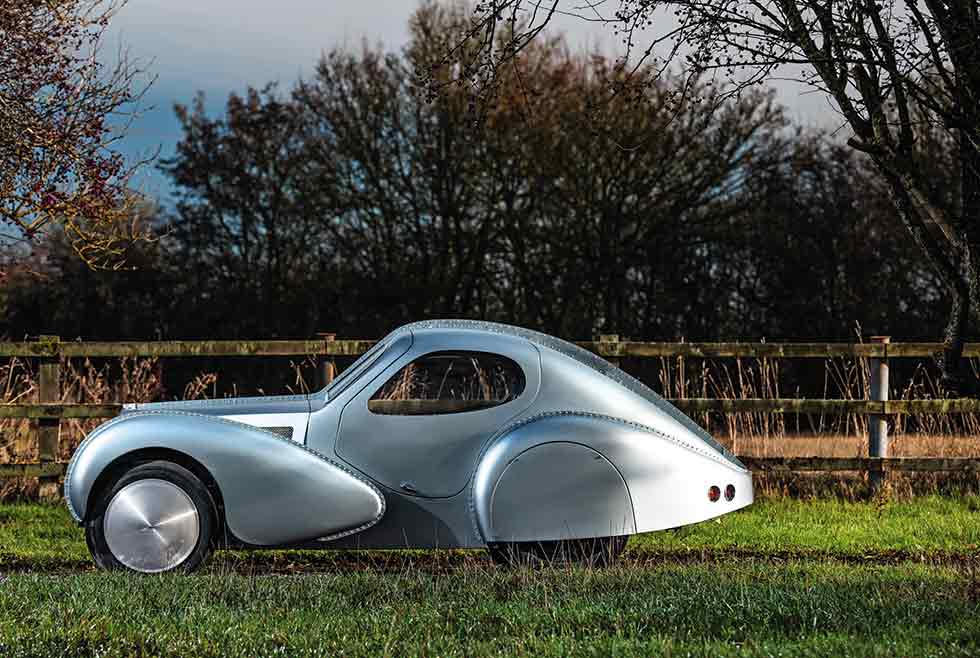
The missing link Charting the remarkable construction of the long-forgotten Bugatti Type 68. A remarkable project is taking shape in rural Buckinghamshire, reviving a long-lost piece of Bugatti history. Words Mick Walsh. Photography Olgun Kordal.
MOLSHEIM IN MINIATURE
The huge diversity of Ettore Bugatti’s design projects is one of the many impressive achievements of the famed engineer. From Grand Prix greats to factory workshop vices, powered bicycles to aero engines, few automotive legends tackled such a multiplicity of engineering challenges.

Despite the turmoil of war, the loss of his talented heir Jean, and the German occupation of his Molsheim factory, Ettore’s brilliant mind remained as prolific as ever. The drawing board of his new office in Levallois-Perret, Paris, must have been thick with sketches and plans for ever more diverse ideas to rejuvenate the great marque in those turbulent times. At the heart of these ideas was a series of new engines, ranging from a single-cylinder unit to mount on a bicycle to a 62-litre, eight-cylinder marine powerplant.

As always, automotive applications were the key focus, and none were more fascinating than the bold Type 68, a double-overhead-camshaft 318cc ‘four’ to power a new compact range for the immediate post-war age.
In addition to racers and high-performance exotics, Bugatti had a tradition of small, neat machines that harked back to the Edwardian era with the 855ccc Bebe Peugeot and the brilliant Type 13 ‘Brescia’. The new engine, with four valves per cylinder, gear-driven camshafts and supercharged induction, was designed to rev to 12,000rpm. Known as the ‘long bolt’ unit after the method used to secure the cast-iron cylinder liners between the head and crankcase without gaskets, the new design confirmed that the great engineer had lost none of his creativity. The one-piece aluminium crankcase featured three bearings with a caged roller centre.
“With classic Bugatti features scaled down, such as the oil filter, it’s a jewel of a thing,” enthuses marque specialist Tim Dutton. “The valves are so small they look like nails, and the compact Roots-type supercharger on the nose of the crankshaft is just like the one that drives a suction pump on a modern F1 engine.”
It is believed that just three T68 engines were made, and Le Patron himself tested one in a motorcycle frame of his own design. Several car applications with different body styles were planned, but just one, a puggish-looking two-seater runabout, was completed for testing. This little-seen prototype was later saved from scrap by the Schlumpf brothers, and today is displayed without an engine in the Cite de l’Automobile, Mulhouse. It’s believed that three ‘underslung’ T68 chassis frames were also completed.
Among the Type 68 drawings were several sketches done by 25-year-old Roland Bugatti, Jean’s younger brother, for a dramatic two-seater coupe with ‘gullwing’ doors, and a roadster with cutaway sides and ‘Grand Raid’-style head fairings. But with the death of Ettore in 1947, the Type 68 project lost focus as Roland and new director Pierre Marco revived car production with the Type 101, a thinly disguised pre-war Type 57. Grand Prix ace Maurice Trintignant remembered testing the Type 68 in the early ’50s, but the fluid flywheel proved problematic and eventually the prototype was pushed into storage to gather dust, while the drawings were stashed away in packed plan chests, lost among a multitude of ideas and dreams.
Fast-forward to the 1970s and passionate German Bugatti fan Uwe Hucke had become absorbed in everything about the great French marque. Over the years, Hucke saved and restored a fantastic range of legendary cars including the four-wheel-drive Type 53, T57G Le Mans ‘Tank’ and T30 ‘Strasbourg cigar’ Grand Prix car. There was no limit to his enthusiasm, which extended to creating a series of ‘what ifs’ including a Royale Speedster and a 1915 14-litre aero-engined special. Mentored by Hugh Conway Snr, his close friend and Bugatti guru, Hucke also began rescuing factory drawings, which included the fascinating designs for the little-known T68 project.

As well as blueprints, Hucke sourced an extensive selection of T68 parts including a chassis frame, back axle and incomplete power unit. “In around 1996, Uwe showed me the engine components, which included an alloy crankcase, a part-finished cylinder head, camshafts, valves and conrods, with the idea of assembling it for display,” recalls Richard Day, then curator of The Bugatti Trust. “The first plan was to make a wooden block and spray it silver, but we concluded that it would be a shame not to do it properly and make the engine work.”
Hucke’s passion for Bugatti’s work inspired all those involved in his projects. “It was an incredible design for the time,” says Day, “but would have been too expensive to produce because the critical machining of the cylinder head would have been impractical in 1945. You have to remember that it was still at prototype stage, and only three engines were made. But as with so many of Ettore’s design ideas, the T68 was way ahead of its time. When dismantled, Japanese motorcycle engines from the ’70s looked expensive to produce, but mass-production techniques had been transformed.
“This was a pre-production unit, and at least 10 engines would have been tested and destroyed before the engineers got it right. Ettore appreciated the production challenge of the 16-valve cylinder head, which is why he revised the design for the T68B with a simpler eight-valve head. ” Working with a near-complete set of original factory drawings and a newly cast block, Day enthusiastically set about completing the short-lived 16-valve unit: “It’s a beautiful motor, with so many clever features. The timing tower gears, for example, drive everything including cams, lubrication system, water pump and ignition.” After years of work, Day loosely assembled the engine on his workbench for a test run. With temporary electronic ignition in place of the original four coils and contact breakers, the unit fired and ran for three seconds at 1500rpm, its success adding extra impetus to the project.
For the transmission, Bugatti had planned a two-speed ’box with fluid flywheel, or possibly a Cotal electric, but for practical reasons Day used modern Reliant gears inside a Bugatti-style casing. Tim Dutton and his father Ivan were involved with the project from the outset, when Hucke commissioned them to fit the axles and steering. “The suspension – solid axles and leaf springs with reversed quarter-elliptics at the back-is typical Ettore,” says Tim. “If something worked well, it was continually developed. This would handle better than early independent solutions such as the Fiat 500 or Alfa 2.9. Only on rough roads would it show its limitations.” With the engine and chassis sitting on four wheels, work started in earnest on the ‘gullwing’ coupe body, based on Roland Bugatti’s sketch.
Hucke enlisted Steeve Bernaud-Heyd, a young French stylist who had been employed by Romano Artioli at Bugatti Automobili SpA in the futuristic Campogalliano factory. “Working on the EB110, I loved my job and embraced the Bugatti universe,” says Bernaud-Heyd, “so when Uwe started talking about the amazing T68 project I loved the idea. Roland’s sketch was very simple, and I had to reinterpret his lines to create a shape that could fit an adult and work ergonomically but still capture the Bugatti spirit. The dimensions of the chassis were unconventional with such a small engine, but I like to think Ettore would be proud of our work. For that time, the idea was very sophisticated.”
Hucke then instructed coachbuilder Terry Hall to make the body using Bernaud-Heyd’s scale drawings. A set of profile sections was cut to evaluate the shape, before Hall began masterfully rolling and shaping the aluminium to create its fantastic form. During construction Michel Bugatti, Ettore’s son from a second marriage, visited Hucke and loved the ‘mini Atlantic’.
The project came to a halt after Hucke’s death in April 2002, following a long illness. The unfinished T68 was inherited by his daughter, Angela, who shared his passion for the marque and became closely involved with The Bugatti Trust. After a period in storage, in early 2018 the silver coupe was taken to Paris for display on Dutton’s stand at Retromobile. In the very city where Ettore conceived the T68, and later when exhibited at the Trust’s Prescott headquarters, the coupe created avid interest in Bugatti’s final designs and much discussion on social media. “I was nervous at first, but the reaction has been fantastic, which is a great tribute to my father,” says Angela. “Visitors loved the car, particularly children, and during sketching classes one small boy spent ages detailing every rivet. At the Motorcycle Festival, ’bike fans loved the idea of the Type 68’s engine producing performance through high revs and light weight – particularly specials builder Allen Millyard.”
The project now needs a new enthusiast to complete it, because Hucke would rather acquire a more practical vintage car that her daughters can immediately enjoy. “It’s 80% done and just needs finishing with all the little things – cooling, wiring, clutch and trim – to make it work,” says Dutton. “Ettore never resolved the airflow through the cockpit, so with fixed windows it will need vents. It’s a remarkable design that shows how ahead of the game he was. Who else in 1945 was thinking about material shortage, limited fuel supply and city congestion?”
With the 110th anniversary of the marque in 2019, wouldn’t it be great to see the Type 68 run up Prescott, or being displayed beside the T57SC Atlantic and T51 Dubos Coupe? Architects such as Day seem to be drawn to the work of Bugatti, so perhaps Lord Foster might fund the T68’s completion as the perfect addition to his inspiring Foundation in Madrid.

“The chassis dimensions were unconventional with such a small engine, but I like to think Ettore would be proud of our work”
BUGATTI: MORE THAN JUST CARS
Ettore Bugatti was so much more than simply an automotive engineer, as his diverse range of patents, design challenges, eclectic interests and wide circle of influential friends attest. Today he would be called an industrial designer, but his broad perspective went way beyond invention: Ettore was just as fascinated by the production of his creations, too. Throughout his working life he designed lathes and machines for drilling, cutting and many other aspects of manufacture. Even the workbenches around the Molsheim factory featured vices designed by Bugatti that, like all of his engineering work, were aesthetically impressive – and today are highly prized.
As historian Barry Eaglesfield confirms in his exhaustive Bugatti: The Designer, the breadth of work beyond his automotive marvels is remarkable – from door hinges to operating tables, fishing reels to 2000bhp streamlined trains.
Whatever interest distracted Ettore from his drawing board, be it equestrian or nautical, he’d soon set about dreaming up new solutions – as his elegant marine snatch block, designed for his yacht Barbara III and patented in 1940, confirms.
During the 1930s, the Italian-born Bugatti even created a pasta machine for the cooks in his chateau kitchen, using parts from Bugatti cars including a Royale steering wheel and gears from Grand Prix racers to produce spaghetti, macaroni and tagliatelli. This unique culinary masterpiece was advertised in the 1980s for £35,000.
Always beautifully executed, the designs could be as elegantly simple as the wooden chairs he designed for waiting customers at the factory. Little wonder modern designers such as Marc Newson find inspiration in Bugatti’s work.
A complete contrast came from the Type 56 that made its debut on the Bugatti stand at the 1931 Paris Salon alongside son Jean’s glamorous straight-eight Type 49 coupe. Looking like a veteran with its tiller steering, this small, light, two-seater electric car was originally designed by Ettore for personal use around the factory grounds and estate. With its 36V motor geared directly above the back axle, the silent vehicle was much admired by customers who requested that he build more, but no doubt the FFr10,000 price put most off.
The financial crash in 1929 wiped out many exclusive car makers, and with Bugatti production nearly at a standstill between 1932 and ‘1934 it was a railway contract that rescued the firm. After the financial failure of the Royale, Ettore designed the advanced Autorail, which conveniently used four redundant 12.7-litre Royale engines for power. With engines arranged in the centre, this streamlined 16-wheeler reached record speeds including a 144kph average between Strasbourg and Paris. Autorail production totalled 88 and it remained in service up to 1958, proving to be one of Bugatti’s most financially beneficial projects and undoubtedly saving the company.
Other automotive engineers have diversified into rail and aviation, but none matched Ettore’s varied achievements. Proud, extravagant, dynamic, artistic, stylish, eccentric, blinkered, moody, compassionate and egotistical: Le Patron was all of these during his packed 65 years.







